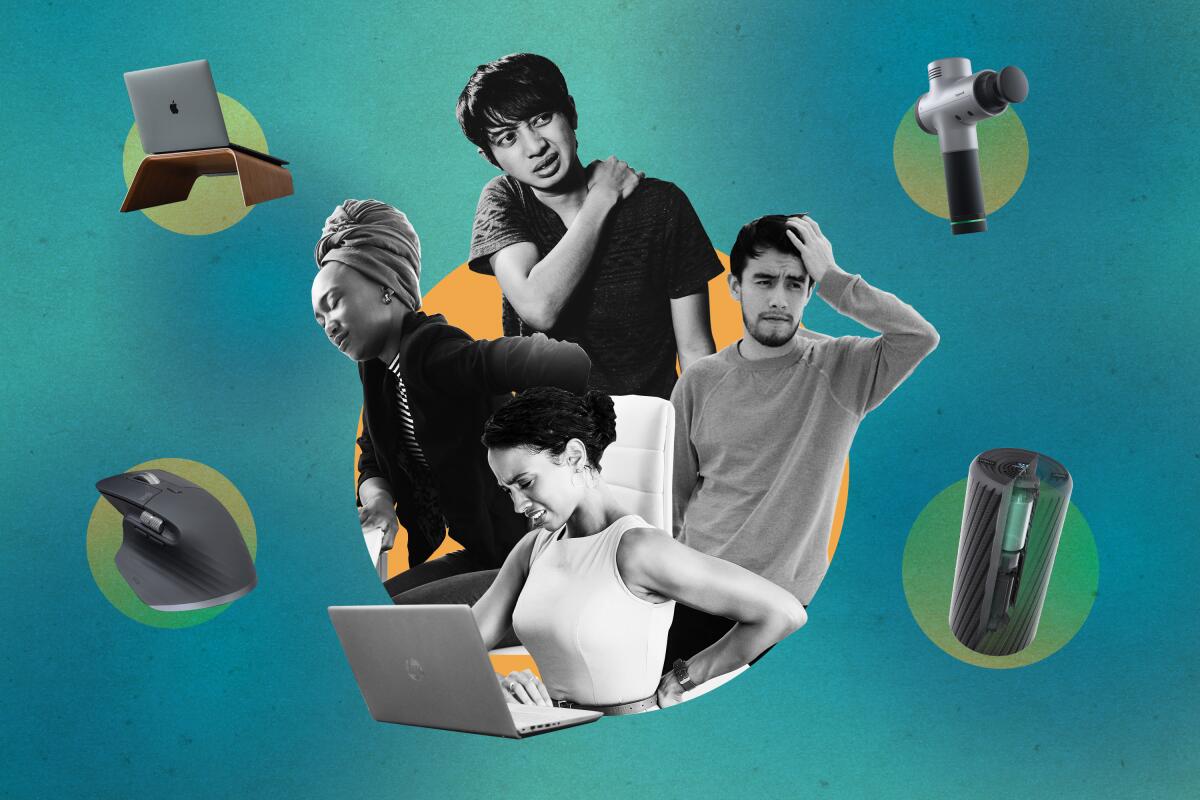Working from home takes a physical toll — and companies are trying to profit from that

Lindy Burns had every intention of getting a proper desk and chair after the pandemic forced her to start working from home. As a yoga therapy clinic owner, she understands the importance of posture more than most.
A year later, “I tend to work a lot in the bed or on the floor using the bed as a desk,” Burns, 38, said. “I’m basically in a deep hip flexion all the time, and it’s really causing pain and strain at the hamstrings.”
For many who have been working remotely since March 2020, the home office never truly became one — just a makeshift setup meant to suffice for a few weeks or so. At which point life would surely be back to normal, right?
But those less-than-ideal workstations — monitors too small and too low; desks that don’t adjust; chairs without armrests and back support; built-in keyboards and touchpads instead of external ones — combined with sedentary work habits have taken a physical toll as the pandemic has dragged on.
Remote workers report suffering from aches and pain, joint soreness, stiffness, numbness, carpal tunnel and headaches. That’s a concern for employers, especially as many adopt permanent work-from-home policies, and a boon for the businesses that are offering solutions such as pain-relief devices, office equipment and ergonomic consulting.
“I have a constantly tense upper back and shoulders, and issues in my lower back right at the base of my spine,” said Rose Salm, a tax accountant from Vancouver, Canada. “I think my head is too far forward. Maybe it’s the screen angle or something, but I have muscle pain at the top of my neck.”
Salm, 26, also blames an environment that makes it too easy to spend hours at a time motionless.
“In the office, you’re encouraged to get up and walk around,” she said. “Now that I’m at home by myself, I don’t really get up at all unless I’m hungry or something.”
Her ailments are being echoed at doctor’s offices, on company Slack channels and across social media as workers struggle to adapt:
“Working from home is mashing up my back and neck.”
“I might need to improve the ergonomics of my working-from-home setup because ever since I started working again my neck has been killing me.”
“I converted my desk into a standing desk by literally just stacking boxes on it and it has made a world of difference for my posture, as well as neck, back, and shoulder pain.”
Doctors and chiropractors point to a number of contributing factors. Office workers had professional workstations and, at many companies, access to ergonomic specialists. Just as important, work lives revolved around a daily routine: getting dressed and commuting, attending meetings, taking coffee breaks, walking outside to grab lunch, maybe going to the gym.
“There was forced movement. And now all of a sudden that routine is gone,” said Scott Bautch, president of the American Chiropractic Assn.’s Council on Occupational Health. “There was not much transference of the work environment to the home environment.”
Last spring, the chiropractic association polled its members and found that 92% of respondents said they’d seen an increase in musculoskeletal conditions such as back and neck pain as a result of patients working from home. In follow-up polls conducted over the summer, 57% of respondents said lack of movement was the main reason those issues were on the rise during the pandemic, followed by psychological stress (20%) and poor posture (12%).
Some employers, particularly those in the technology sector, have provided substantial support to get their workers set up correctly.
At Twitter, employees receive $1,000 to furnish and equip their home offices, which can include AirPods, foot rests, air purifiers and “videoconferencing soft lighting setups,” a spokesperson said.
Salesforce offered its workers a $250 initial reimbursement in the spring to help cover the costs of at-home office-related equipment; it supplemented that with an additional $250 in the fall. The San Francisco company also provides all of its employees access to an ergonomic assessment with a specialist, a spokesperson said.
Shopify gave each of its employees a $1,200 remote-work allowance last March and an additional $1,440 after it announced two months later that it would move to a permanent work-from-anywhere structure even after the pandemic ends. Besides the usual office basics, employees have used the money to buy espresso machines, slippers, bean bag chairs and an “office snack shelf.”
“We trust our employees and didn’t have set guidelines for this remote allowance,” said Brittany Forsyth, Shopify’s chief talent officer.
The mass migration of white-collar workers away from their cubicles has created an unexpected opportunity for furniture makers whose customers have historically been companies instead of individual consumers.
“Office chairs — they’re selling like hotcakes right now,” said Annette Bernat, a spokeswoman for the chiropractic association.
Last year, office furniture giant Herman Miller saw its stock plummet 62% from Feb. 21 to March 18 as corporate America was abruptly upended.
The Zeeland, Mich., company quickly regrouped. A few months ago, Herman Miller began opening its first retail stores, selling its ubiquitous Aeron chairs and other high-end office furniture directly to consumers.
Its first store opened in November at Westfield Century City, followed by a second in Manhattan a few weeks later; the company is planning to open several more across the country this year. Its stock has since recovered, nearly tripling in price in the last 12 months.
“The big shift we’ve been making this year is really about positioning these products to the consumer as a wellness and performance product,” said Debbie Propst, Herman Miller’s president for retail.
“Much in the same way that the mattress industry has really driven this message around ‘There are all these benefits of getting a great night’s sleep,’ we have the same opportunity with the ergonomic seating category: Sitting is bad for you, but if you’re going to sit, you have to sit well.”
In the office, you’re encouraged to get up and walk around. Now that I’m at home by myself, I don’t really get up at all unless I’m hungry or something.
— Rose Salm, 26, a tax accountant
Brands that sell pain management solutions are also seeing sales surge. After the pandemic began, dozens of companies reached out to Hyperice to inquire about buying its Hypervolt hand-held massage devices, vibrating foam rollers and other products for their employees, Chief Executive Jim Huether said.
“We created a more aggressive plan so employers could act accordingly,” he said, including raising its discount on corporate bulk orders to 20% from 10%. Netflix, LinkedIn, Google and Nike were among the 250 companies that purchased Hyperice products for their remote workers.
As a result, sales of the Irvine company’s $249 Venom wearable back device increased 300% in 2020 compared with the previous year and total revenue rose 40%, Huether said. He said the growth was “driven by the explosion of at-home fitness and wellness” during the pandemic.
I’ve looked into good chairs and good desks, but the costs have outweighed the benefit at this point.
— Lindy Burns, 38, a yoga therapy clinic owner
Good products help, but workers say they’re also trying to educate themselves about healthy ergonomic practices.
After months of working from home, Rachael WilderJones, 37, was coping with a host of issues: “Fatigue. A lot of lower back pain. My legs going to sleep while I was sitting at the desk. Waking up in the middle of the night with sharp pain,” said WilderJones, a customer service rep for a large health insurance provider.
She began taking pain medications, but “it was just covering up the issue instead of getting to the root cause,” she said. When her company began promoting a partnership with San Francisco start-up Hinge Health, she signed up in October.
Hinge Health provides clients with a digital healthcare program to help them manage their musculoskeletal problems. WilderJones was sent a yoga mat, exercise bands and a tablet preloaded with a health app that pairs with wearable sensors. She was also assigned a physical therapist and health coach.
“It’s you basically taking a hands-on approach to your care as opposed to taking medications or seeing chiropractors,” said WilderJones, who lives in Durham, N.C. Learning to stretch properly is “saving my life.”
Hinge Health said its customer base tripled and its revenue quadrupled in the first 10 months of the pandemic. In January, the company announced it had raised $300 million in venture capital, giving it a $3-billion valuation.
For workers whose companies haven’t provided assistance, financial or otherwise, medical experts say there are still a number of things they can do on their own. Bautch, of the chiropractic association, said the most important thing is to remember to move regularly.
Every 15 to 20 minutes, “we need a five-second break to get our nose and toes as far apart as possible — anything that takes your forward-looking posture and makes an extension,” he said. “It’s the rule of opposites: If I’m looking forward, I need to look backwards. If I’m looking left, then I need to look right.”
If your desk is fixed in place, he said, raise your monitor using books so that your screen is at eye level. If you’re using a laptop, relocate to different places around the house during the day — starting at your desk and then standing at a counter for a while, for instance.
If you don’t have a proper office chair and can afford to buy one out of pocket, look for one with an adjustable height and a “waterfall front” — the downward slope relieves pressure from the knees. Occasionally sitting on an exercise ball instead of at a desk chair also helps. Invest in a separate keyboard.
Bautch acknowledged that the cost of those products can add up, but “it’s your body. Don’t worry about who’s paying for it.”
But after making do for months, and with some return to normalcy in sight, Burns said she plans to ride out the pandemic with her bed-and-floor arrangement.
“I’ve looked into good chairs and good desks,” she said, “but the costs have outweighed the benefit at this point.”
Burns caught a lucky break two weeks ago, when she was driving to her home in Catonsville, M.D., and spotted an office chair on the side of the road with a “free” sign on it.
The chair is in her bedroom now. “But I don’t have a desk to work at it with.”
More to Read
Inside the business of entertainment
The Wide Shot brings you news, analysis and insights on everything from streaming wars to production — and what it all means for the future.
You may occasionally receive promotional content from the Los Angeles Times.












